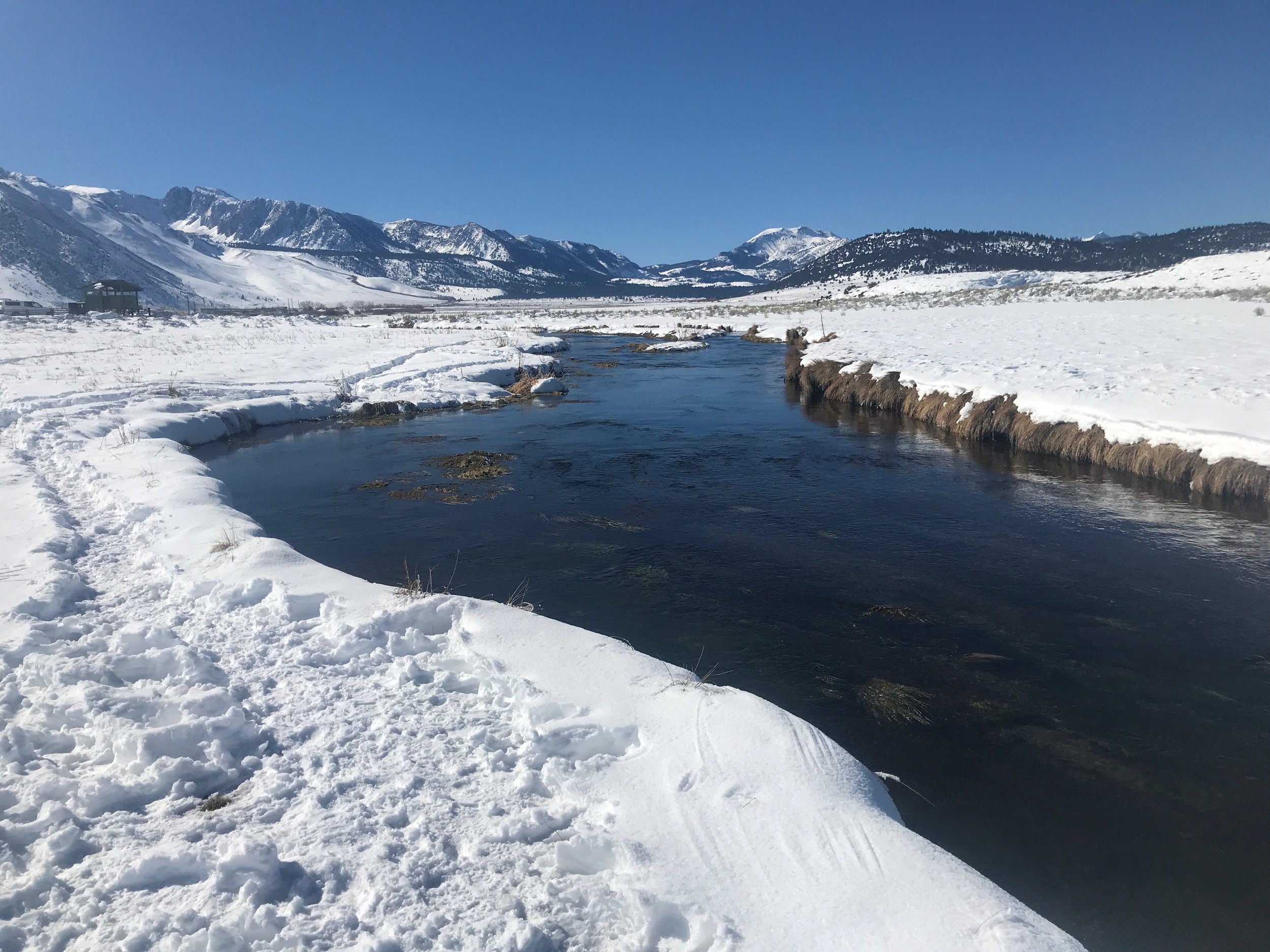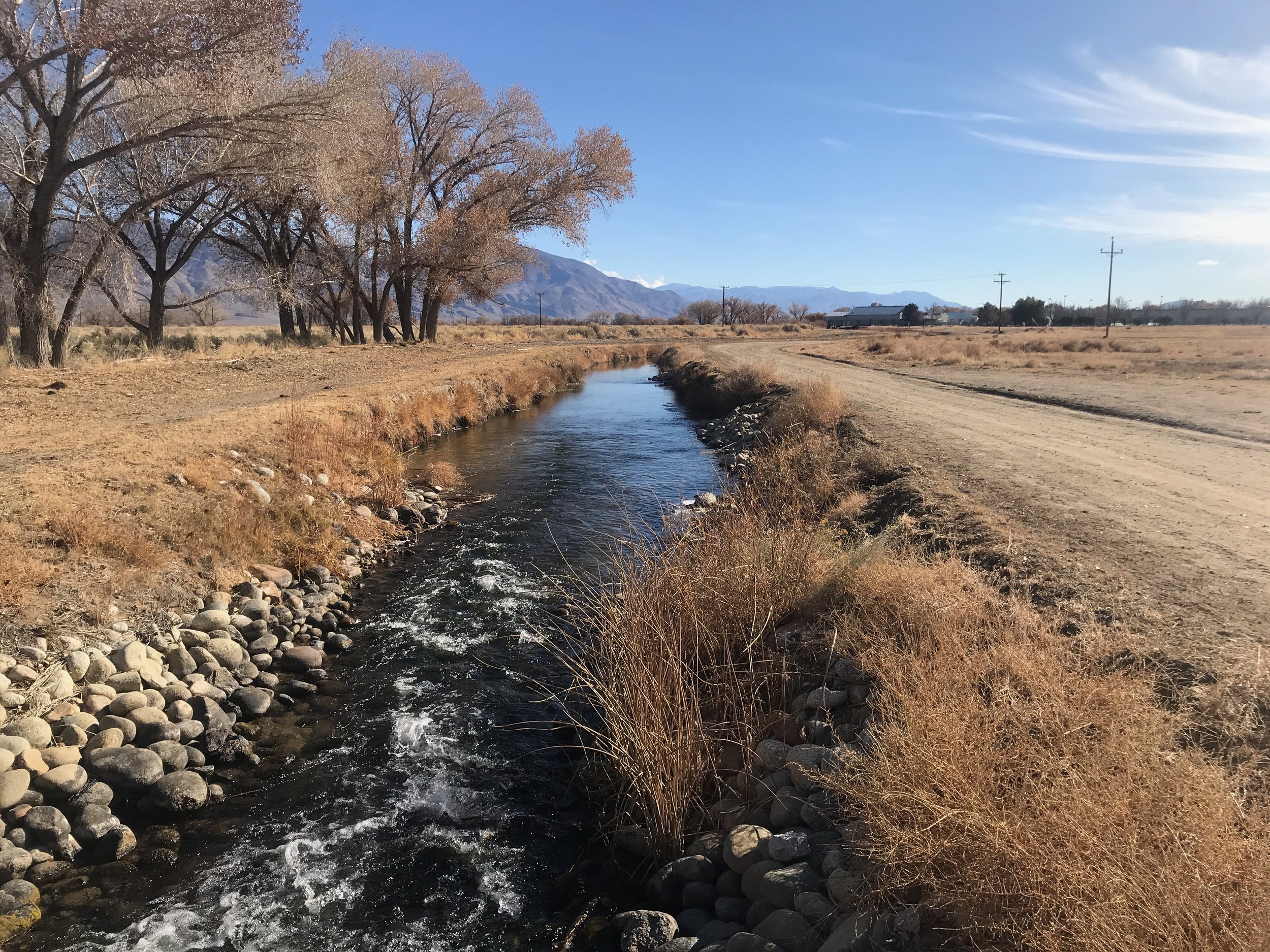Fly fishers are aware of the dog days of summer when the temperatures in the stream rise to the point that the trout become lethargic. The same phenomenon happens in winter when the water gets so cold that the trout’s diet is nonexistent. From the middle of December through mid to late January the trout’s nutritional requirements are at their lowest. During these times you need to put your fly pattern right in front of the trout. If I take four to six casts to cover a spot in the summer time, I’m taking 18 to 24 casts in the winter time to cover the same water. Midges and blue wing olive mayflies are the predominate winter insects in Eastern Sierra moving waters. I also through some big morsels, stone fly nymphs, to entice the bigger trout to feed on as easy meal. The latest storms left up to three feet of snow at the upper elevation peaks in the Eastern Sierra.
Sierra Bright Dot owner Fred Rowe taking advantage of an overcast day on the lower Owens River while the storm leaves snow on the upper elevation peaks.
Lower Owens River:
Wild Trout Section:
Blue wing olive hatches in the middle of the day, 11:00 A.M. to 1:00 P.M., have the trout actively feeding. It’s a short window of opportunity to catch trout this time of the year. There are midge pupae, midge nymphs, and mayfly nymphs the trout are feeding on. Tiger and zebra midge pupae and midge nymphs and blue wing olive nymphs are the flies I’m throwing for the trout. I’m dressing warm, thermals and jacket, to stay in the water fishing for as long as I want. Nymphing with the Euro rod continues to be my productive method of fly fishing the lower Owens River.
Wading upstream where you cannot fish from the bank opens up all kinds of fly fishing spots to explore.
Hot Creek:
Interpretive Site:
This area got up to 18 inches of new snow. Time will tell if enough vehicles will access the road to make the road drivable. Hot Creek is in winter mode with the fish feeding middle of the day if there are midges or blue wing olive mayflies hatching. This is a tough area to nymph fish, but it will be the most productive method for the next month or two.
With the new snow on the ground it will take a few days for anglers to build trails in the snow making access easier like it was before the latest storms.
Hot Creek:
Canyon Section:
Accessing the canyon section with all this new snow is the hurdle of fly fishing in the canyon. Snow shoes or cross country skis will make access easier. There is enough open water sections for fly fishers to be able to nymph. I’m fishing with midge nymphs, pupae, and mayfly nymphs. I’m fishing my nymphs under a size 16 Adams parachute. My tippet under the dry fly is 18 to 24 inches of 5X or 6X fluorocarbon tippet. Success here requires lots of casts to drift the fly right in front of a trout that wants to feed. Effort equals more trout to the hand. Cover the water thoroughly.
Parking is limited on the upper Owens River to parking in and around Benton Crossing Bridge.
Upper Owens River:
Above Benton Crossing Bridge:
Fishing here is still tough as not a lot of trophy trout are in the river. Successful fly fishers are covering lots of water looking for the few trophy trout that are feeding and resting in the deep holes, runs, and cutbanks. Access is by foot, snowshoes, cross country skiing, or snowmobiles. The better runs and holes are about an hour’s walk up upstream of Benton Crossing Bridge. I’m fishing with larger nymph imitations on my Euro rig. I like fishing with a stoner nymph and a green/gold Prince nymph for the trophy trout.
Bishop Creek Canal is at its lowest levels of winter and fly fishing is tough right now.
Bishop Creek Canal:
Behind the Ford Dealer:
Fishing here is tough as water levels are at their lowest levels. There are a few trout here and there, but they are very spooky. Middle of the day is the best time to be on the water. Nymphing with the Euro rod, under an indicator, or under a dry fly will produce a few trout. Most indicators are spooking the trout. Yarn indicators or a dry fly will spook less trout. I’m nymphing with zebra midges, tiger midges, blood midges, bead head flash back pheasant tail nymphs, and olive quilldigons.





